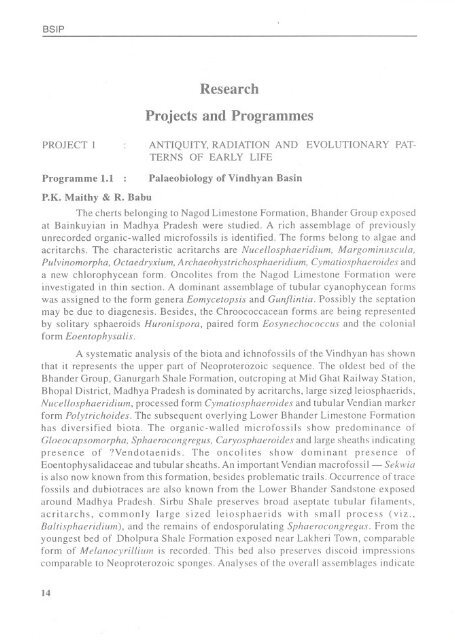1996-97 - Birbal Sahni Institute of Palaeobotany
1996-97 - Birbal Sahni Institute of Palaeobotany
1996-97 - Birbal Sahni Institute of Palaeobotany
You also want an ePaper? Increase the reach of your titles
YUMPU automatically turns print PDFs into web optimized ePapers that Google loves.
BSIP<br />
Research<br />
Projects and Programmes<br />
PROJECT 1<br />
Programme 1.1<br />
ANTIQUITY. RADIATION AND EVOLUTIONARY PAT<br />
TERNS OF EARLY LIFE<br />
Palaeobiology <strong>of</strong> Vindhyan Basin<br />
P.K. Maithy<br />
& R. Babn<br />
The cherts belonging to Nagod Limestone Formation. Bhander Group exposed<br />
at Bainkuyian in Madhya Pradesh were studied. A rich assemblage <strong>of</strong> previously<br />
unrecorded organic-walled micr<strong>of</strong>ossils is identified. The forms belong to algae and<br />
acritarchs. The characteristic acritarchs are Nucellosphaeridium. Margominuscula.<br />
Pulvinomorpha. Octaedryxium, Archaeohystrichosphaeridium, Cymatiosphaeraides and<br />
a new chlorophycean form. Oncolites from the Nagod Limestone Formation were<br />
investigated in thin section. A dominant assemblage <strong>of</strong> tubular cyanophycean forms<br />
was assigned to the form genera Eomycetopsis and Gunilintia. Possibly the septation<br />
may be due to diagenesis. Besides. the Chroococcacean forms are being represented<br />
by solitary sphaeroids Huronispora. paired form Eosynechococcus and the colonial<br />
form Eoentophysalis.<br />
A systematic analysis <strong>of</strong> the biota and ichn<strong>of</strong>ossils <strong>of</strong> the Vindhyan has shown<br />
that it represents the upper part <strong>of</strong> Neoproterozoic sequence. The oldest bed <strong>of</strong> the<br />
Bhander Group. Ganurgarh Shale Formation. outcroping at Mid Ghat Railway Station.<br />
Bhopal District. Madhya Pradesh is dominated by acritarchs. large sized leiosphaerids.<br />
Nucellosphaeridium. processed form Cymatiosphaeraides and tubular Vendian marker<br />
form Polytrichoides. The subsequent overlying Lower Bhander Limestone Formation<br />
has diversified biota. The organic-walled micr<strong>of</strong>ossils show predominance <strong>of</strong><br />
Gloeocapsomorpha, Sphaeracollgregus, Caryosphaeroides and large sheaths indicating<br />
presence <strong>of</strong> ?Vendotaenids. The oncolites show dominant presence <strong>of</strong><br />
Eoentophysalidaceae and tubular sheaths. An important Vendian macr<strong>of</strong>ossil - Sekwia<br />
is also now known from this formation, besides problematic trails. Occurrence <strong>of</strong> trace<br />
fossils and dubiotraces are also known from the Lower Bhander Sandstone exposed<br />
around Madhya Pradesh. Sirbu Shale preserves broad aseptate tubular filaments.<br />
acritarchs. commonly large sized leiosphaerids with small process (viz ..<br />
Baltisphaeridillm), and the remains <strong>of</strong> endosporulating Sphaerocollgreglls. From the<br />
youngest bed <strong>of</strong> ))holpura Shale Formation exposed near Lakheri Town. comparable<br />
form <strong>of</strong> Melallocyrillillll1 is recorded. This bed also preserves discoid impressions<br />
comparable to Neoproterozoic sponges. Analyses <strong>of</strong> the overall assemblages indicate<br />
14

















